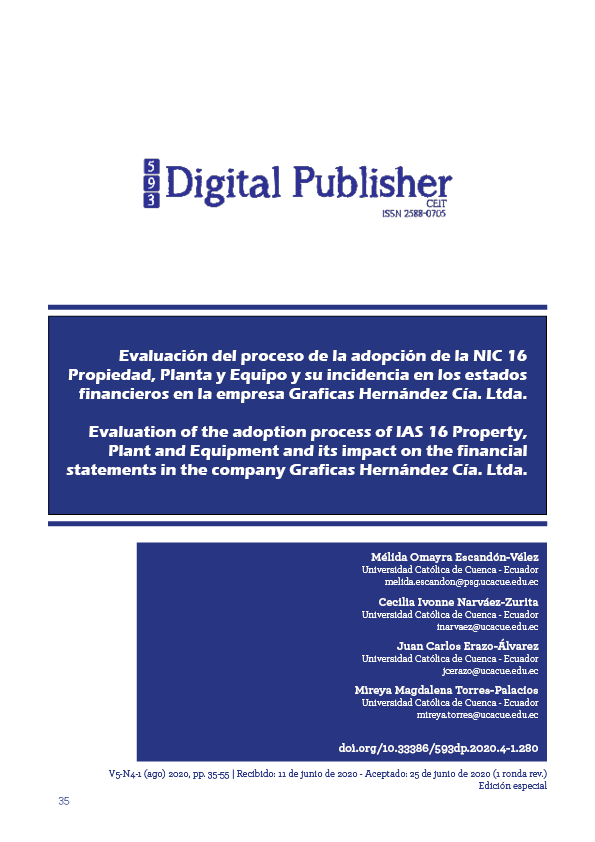Evaluation of the adoption process of IAS 16 Property, Plant and Equipment and its impact on the financial statements in the company Graficas Hernández Cía. Ltda.
Main Article Content
Abstract
The implementation of IFRS in Ecuador has made accounting information transparent and has thereby contributed to the development of the country by having information that is comparable, pertinent, accurate and in real time for decision-making. The gap between book values versus the reality of companies has also diminished, especially in the most significant assets such as property, plant and equipment. Based on the foregoing for the company Gráficas Hernández, the IFRS adoption process was partially carried out, since at that time there was no clarity on the applicability of the accounting technique, a situation that arises from the lack of training in staff for the correct application. For this reason, this research aims to design a procedures manual to evaluate the process of adopting IAS 16. The methodology used was of a non-experimental type with a qualitative approach, its descriptive scope and inductive-deductive was used among the methods, since it was of general concepts of internal control, components and adoption process of IFRS in Ecuador, reaching the treatment established by the accounting technique IAS 16. Among its results it was found that the company did not consider all the provisions of IAS 16 to its implementation and subsequent control, since it does not have established policies for its treatment for this reason through this proposal, what is intended is to give the guide to obtain the real valuation of the assets, allowing the reasonableness of the financial statements.
Downloads
Article Details
1. Derechos de autor
Las obras que se publican en 593 Digital Publisher CEIT están sujetas a los siguientes términos:
1.1. 593 Digital Publisher CEIT, conserva los derechos patrimoniales (copyright) de las obras publicadas, favorece y permite la reutilización de las mismas bajo la licencia Licencia Creative Commons 4.0 de Reconocimiento-NoComercial-CompartirIgual 4.0, por lo cual se pueden copiar, usar, difundir, transmitir y exponer públicamente, siempre que:
1.1.a. Se cite la autoría y fuente original de su publicación (revista, editorial, URL).
1.1.b. No se usen para fines comerciales u onerosos.
1.1.c. Se mencione la existencia y especificaciones de esta licencia de uso.
References
Agreda Palacios, X. (2013). Normas internacionales de información financiera: avances en su aplicación en Estados Unidos de América, México y Venezuela. Revista del Centro de Investigación, 10(39), 181-193. Recuperado el 13 de 03 de 2020, de https://www.redalyc.org/articulo.oa?id=34231070012
Arias Pérez, M. G., & Flores Brito, S. X. (2017). La NIC 16 y su impacto en la gestión tributaria en Diario el Heraldo C.A. Obtenido de https://repositorio.uta.edu.ec/bitstream/123456789/25204/1/T3971M.pdf
Brochet, F., Jagolinzer, A., & Riedl , E. (2013). Mandatory IFRS Adoption and Financial Statement Comparability. Contemporary Accounting Research, 1373-1400.
Callao, S., Jarne, J., & Laínez, J. (2007). Adoption of IFRS in Spain: Effect on the comparability and relevance of financial reporting. Journal of International Accounting, Auditing and Taxation, 148-178.
Cano, M., & Estupiñán Gaitán, R. (22 de 01 de 2015). Administración de riesgos E.R.M. y la auditoría interna. vLex - Información jurídica inteligente, 18. doi:https://vlex.com.co
Castañeda Parra, L. I. (enero-diciembre de 2014). Los sistemas de control interno en las Mipymes y su impacto en la efectividad. En-Contexto Revista de Investigación en Administración, Contabilidad, Economía y Sociedad(2), 129-146. Recuperado el 29 de 12 de 2019, de https://www.redalyc.org/articulo.oa?id=551856273008
Committe of Sponsoring Organizations of the Treadway Commission. (2013). Control interno - Marco integrado. España: Copyright. Recuperado el 05 de 01 de 2020, de https://www.academia.edu/14393265/Control_Interno_Marco_Integrado_Relaci%C3%B3n_entre_Objetivos_y_Componentes
Coopers & Lybrand. (1997). Los nuevos conceptos del control interno. Madrid: Ediciones Díaz de Santos, S.A. Recuperado el 14 de 12 de 2019, de https://books.google.com.ec/books?id=335uGf3nusoC&pg=PA149&dq=control+interno+definicion&hl=es-419&sa=X&ved=0ahUKEwiUh72gn7XmAhWk2FkKHTagCZkQ6wEIKjAA#v=onepage&q=control%20interno%20definicion&f=false
Coronel Morocho, J. A., Narváez Zurita, C. I., & Erazo Álvarez, J. C. (2019). Análisis del impacto financiero y tributario a partir de la valuación de inventarios bajo NIIF en la empresa VETNAR S.A. Arbitrada Interdisciplinaria KOINONIA, IV( N°2. Edición especial 2019), 56-83. doi:http://dx.doi.org/10.35381/r.k.v4i2.467
Cuenca Jiménez, M. T., González Torres, M. Y., Higuerey Gómez, Á. A., & Villanueva García, J. (Septiembre- Diciembre de 2017). Adopción NIIF en Ecuador: Análisis pre y post sobre magnitudes contables de empresas cotizadas. X-Pedientes Económicos, 1(1), 30-41. Recuperado el 17 de 12 de 2019, de https://pdfs.semanticscholar.org/9148/2a660e200b398e4b40720a18e1e12150f7fb.pdf
Díaz Becerra, O. A. (Enero a Marzo de 2014). Efectos de la adopción por primera vez de las NIIF en la preparación de los estados financieros de las empresas peruanas en el año 2011. Revista Universo Contábil, 10(1), 126-144. Obtenido de https://www.redalyc.org/articulo.oa?id=117030156008
Díaz Becerra, O., Durán Rojo, L., & Valencia Medina, A. (05 de 10 de 2012). Análisis de las diferencias entre el tratamiento contable y el fiscal para los elementos de propiedades, planta y equipo: el caso peruano. Contabilidad y negocios, 7(14), 5-22. Recuperado el 03 de 01 de 2020, de https://www.redalyc.org/pdf/2816/281624914002.pdf
El Telégrafo. (05 de 04 de 2011). Compañías presentan balances bajo normas internacionales. Implementación de las NIIF. Recuperado el 25 de 02 de 2020, de https://www.eltelegrafo.com.ec/noticias/economia/4/companias-presentan-balances-bajo-normas-internacionales
Honorable Consejo Nacional de la República del Ecuador. (2014). Ley de Compañías. Quito.
Horngren, C. T., Harrison , W., & Oliver, S. (2010). Contabilidad. México: Pearson Eduación de México. Recuperado el 18 de 12 de 2019, de https://www.academia.edu/15423568/CONTABILIDAD_OCTAVA_EDICION_HORNGREN_HARRISON_OLIVER
Hurtado García, K., García Bravo, M. E., Hidalgo Achig, M. F., Hidalgo Achig, M., Guerrero Chicaiza, N. F., & Scrich Vázquez, A. J. (2019). Metodología para el uso de las normas internacionales de información financiera en Ecuador. Espacios, 40(11), 2. Recuperado el 31 de 12 de 2019, de https://www.revistaespacios.com/a19v40n11/a19v40n11p02.pdf
Instituto Nacional de Estadísticas y Censos: Directorio de Empresas. (2019). Directorio de Empresas y Establecimientos 2018. Quito. Recuperado el 01 de 04 de 2020, de https://www.ecuadorencifras.gob.ec/documentos/web-inec/Estadisticas_Economicas/DirectorioEmpresas/Directorio_Empresas_2018/Principales_Resultados_DIEE_2018.pdf
International Accounting Standards Board. (2019). Normas Internacionales de Informacion Financiera (Vol. 3era). Delaware, Estados Unidos: IFRS Foundation. Recuperado el 02 de 01 de 2020, de https://www.ifrs.org/issued-standards/list-of-standards/
Mantilla Blanco, S. A. (2018). Auditoría del control interno (Vol. 4ta ). Bogotá: ECOE EDICIONES. Recuperado el 14 de 12 de 2019, de https://books.google.com.ec/books?id=rMS4DQAAQBAJ&printsec=frontcover&dq=CONTROL+INTERNO&hl=es&sa=X&ved=0ahUKEwjh_Yr2mrXmAhXkwVkKHUcBBfEQ6AEIRTAE#v=onepage&q=CONTROL%20INTERNO&f=false
Palacios Manzano, M., & Martínez Conesa, I. (2005). El proceso de armonización contable en Latinoamérica: Camino hacia las normas internacionales. Contabilidad y finanzas, 103- 117. Obtenido de http://www.scielo.br/pdf/rcf/v16n39/v16n39a09.pdf
Pérez Rico, C., Méndez Rojas, V., Fernández García, C., Alvarado Riquelme, M., & Méndez Rojas, P. (Enero-Junio de 2015). Comunidad Andina de Naciones (CAN), Perú, Colombia, Bolivia y Ecuador: Proceso de convergencia y adopción de las NIIF. Economía y política, 21, 49-63. doi: http://dx.doi.org/10.25097/rep.n21.2015.05
Piedra Herrera, F., Balboa La Chica, P., Déniz Mayor, J., & Suárez Falcón, H. (2009). Contabilidad Financiera (Vol. I). Madrid: Delta. Obtenido de https://books.google.com.ec/books?id=MA4yWasUxKEC&pg=PA265&lpg=PA265&dq=el+consumo+de+los+elementos+que+configuran+las+inversiones+econ%C3%B3micas+del+activo+no+corriente+de+la+empresa+se+materializa+en+su+depreciaci%C3%B3n+o+p%C3%A9rdida+del+valor,+que+p
Quinaluisa Morán, N., Ponce Álava, V., Muñoz Macías, S., Ortega Haro, X., & Pérez Salazar, J. (2018). El control interno y sus herramientas de aplicación entre COSO y COCO. Cofín Habana, 12(1), 268-283. Recuperado el 14 de 12 de 2019, de http://scielo.sld.cu/pdf/cofin/v12n1/cofin18118.pdf
Rivas Márquez, G. (julio-diciembre de 2011). Modelos contemporáneos de control interno. Fundamentos teóricos. Observatorio Laboral Revista Venezolana, 4(8), 115-136. Recuperado el 31 de 12 de 2019, de https://www.redalyc.org/articulo.oa?id=219022148007
Solines Chacón, P. (2008). Resolución N° 08.G.DSC. Quito. Recuperado el 31 de 12 de 2019, de https://www.iasplus.com/en/binary/americas/0902ecuadorresolution.pdf
Vásquez Quevedo, N., Carril Márquez, M., & Pascual García, M. (19 de 12 de 2013). Estado actual de Latinoamérica en relación a su proceso de adopción de las NIIF. Contabilidad y Auditoría Investigaciones en Teoría Contable de la Sección de Investigaciones Contables(38), 55-103. Recuperado el 03 de 04 de 2020, de http://ojs.econ.uba.ar/index.php/Contyaudit/article/view/562/1034
Zamora Cabrera, E. P., Narváez Zurita, C. I., & Erazo Álvarez, J. C. (2019). Incidencia del control interno en la gestión administrativa de las IES. Caso: Departamento de Pastoral, Universidad Politécnica Salesiana. Arbitrada Interdisciplinaria KOINONIA, IV ( N°2. Edición especial 2019), 321-348. doi:http://dx.doi.org/10.35381/r.k.v4i2.477





